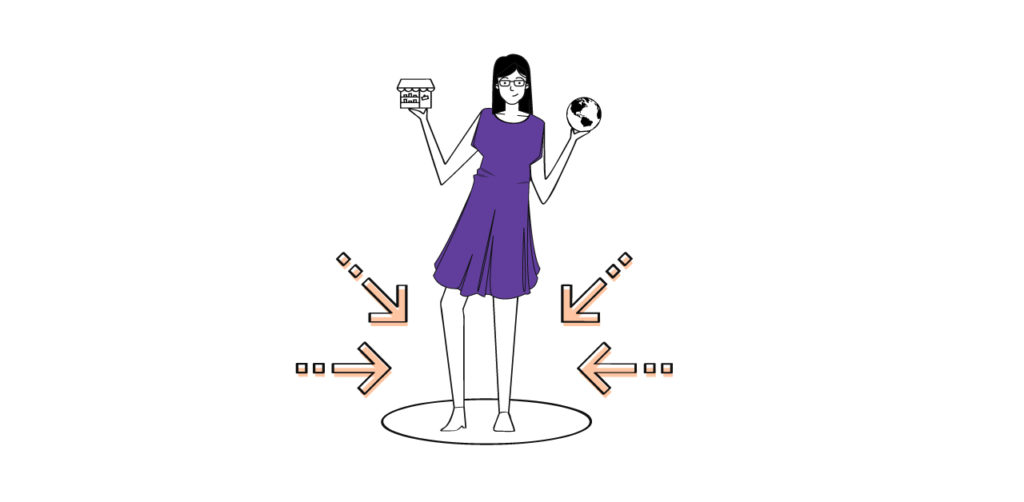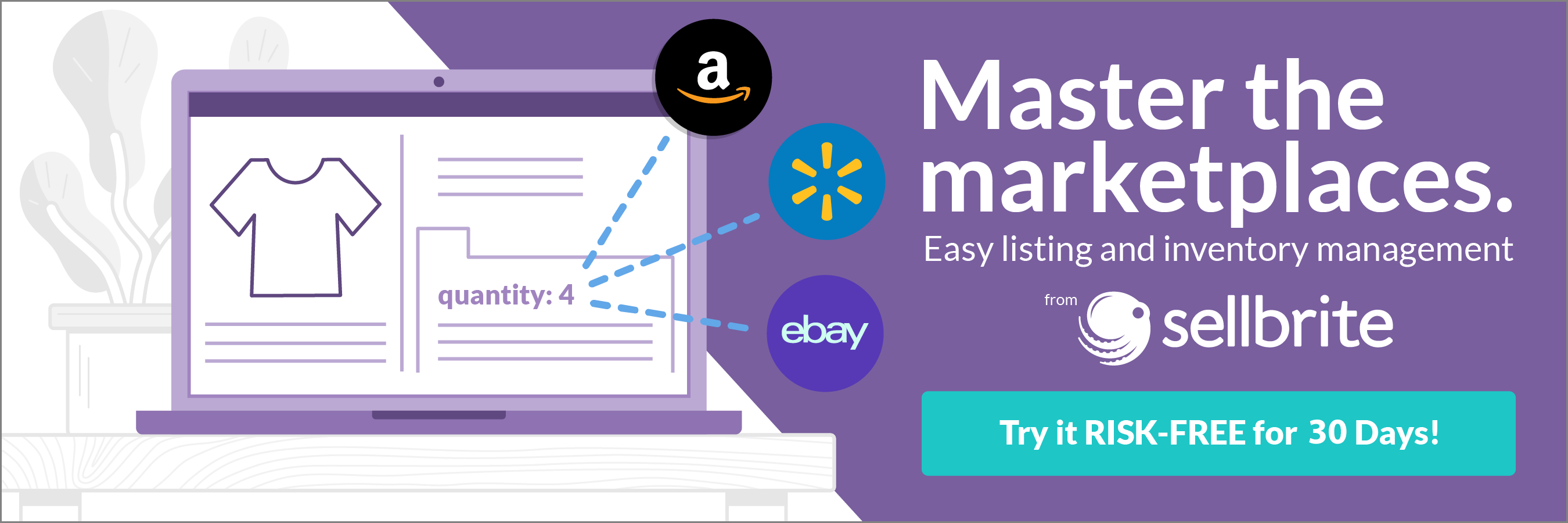Whether you started on a marketplace like Amazon or your own website, you’ve already invested in inventory, fulfillment, and operations for your business. You’ve already set prices, taken product images, and worked out listing details.
Multichannel distribution means taking that foundation and expanding it to new buyers on different channels. Yes, it’s an investment of time and money—but a good one. Our research shows that online sellers on 3+ channels see significantly higher revenue than single-channel sellers.
Multichannel distribution isn’t optional if you want to build a thriving ecommerce business. It’s essential for diversifying your income and reaching new buyers. And, most importantly, it provides a good return on your effort.
To successfully start your journey as a multichannel ecommerce seller, you need to arm yourself with the right knowledge and tools. Sellbrite can help you with both. This guide will demystify the five most important ecommerce sales channels, so you can start expanding your business with confidence.
What is multichannel distribution?
Multichannel distribution is a business model in which a merchant sells their products through several different channels. A business with multichannel distribution is a single entity using multiple platforms and sales methods to distribute its products.
For example, you might sell custom teas via your own ecommerce site, Etsy, and a local boutique and sell wholesale to cafes. Or you may resell white-label products via Amazon, Walmart, and Google.
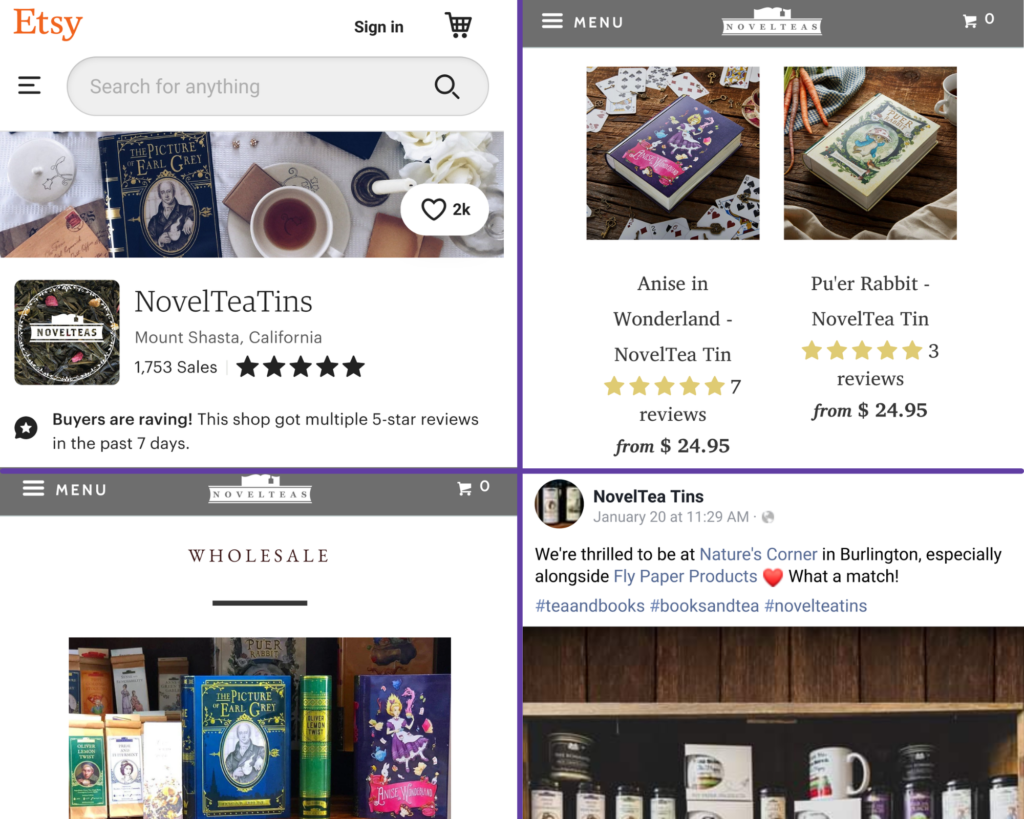
The real work of multichannel distribution is launching and managing your different channels. Marketplaces are the most popular and lowest-lift channels for ecommerce sellers, so those are the channels we’ll focus on today.
Not convinced that multichannel distribution is the right model for your business? Check out our Eight Reasons To Start Multichannel Selling Today.
Amazon: Multichannel selling on the world’s largest marketplace
If you’re not selling on Amazon, you’re missing out on a lot of potential sales. Amazon is the largest online marketplace—and the starting point for 63% of all product searches. Third-party sellers on the Amazon marketplace make up over 50% of its total sales.
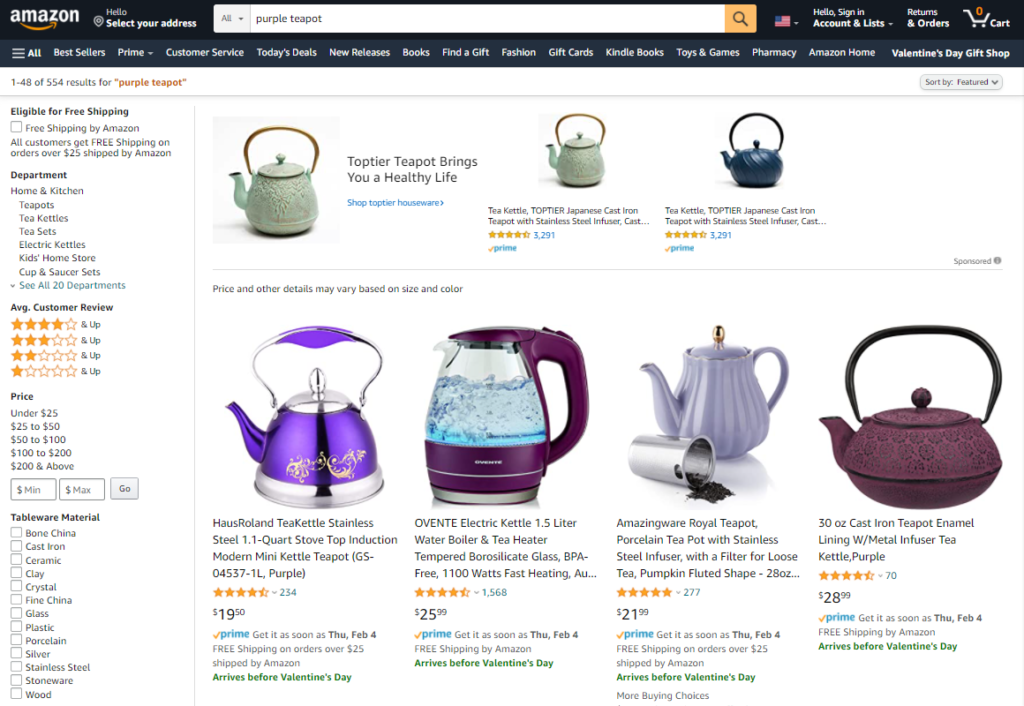
Amazon has two fee structures for sellers. Its Individual plan is geared towards those with lower sales and costs $0.99 per product sold. The Professional plan is $39.99/month, with no limit on products sold. Every seller also pays a referral fee for each product sold, which ranges between 8% and 15% of the sale price for most product categories.
Your experience on this marketplace depends on your Amazon business model, whether that’s selling a proprietary or white-labeled product or reselling someone else’s product.
Resellers will likely have to compete with others selling the same product. In this case, all the products will share one listing and compete for the Buy Box—Amazon’s default payment option. Sellers of unique products own their own listings and only have to compete in search results.
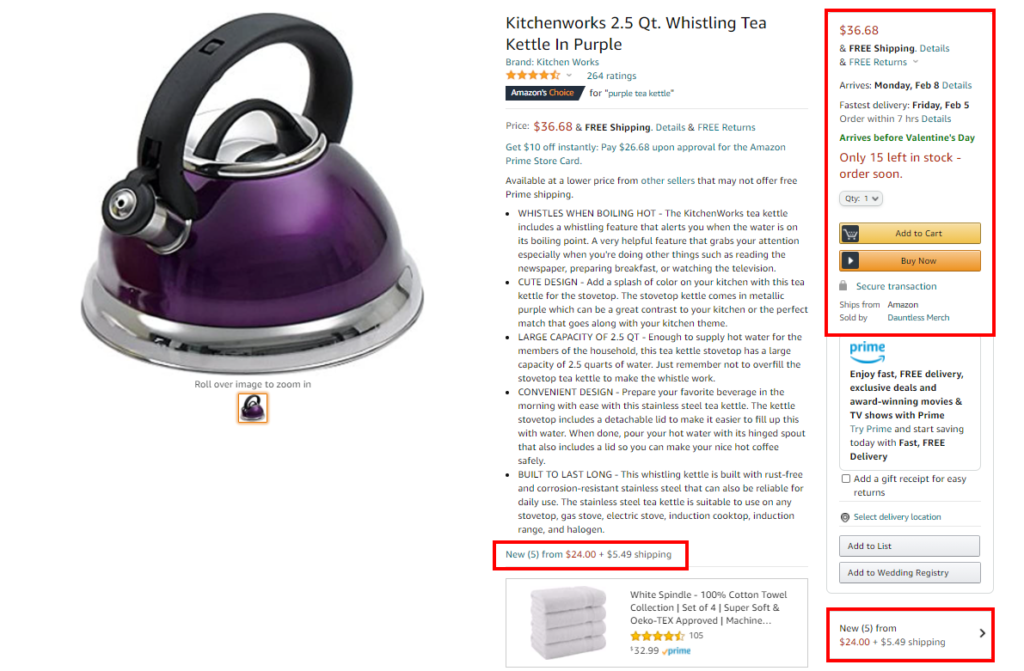
If you’re curious about how to get started selling on Amazon, we’ve got a nifty six-step checklist for acing your first month as an Amazon seller.
Why sell on Amazon: It’s a profitable channel for many business types. Eighty-six percent of sellers are profitable on Amazon, and 74% earn more than $1,000 in monthly sales.
Biggest challenge of selling on Amazon: Competition is fierce, so you’ll need to put effort into optimizing your Amazon product listings for discoverability and potentially using paid promotions, as well. Prime Eligibility is also a major factor for sales, which means you need to provide fast delivery speeds or use Fulfillment by Amazon (FBA).
Should you sell on this channel? Everyone should at least experiment with Amazon—the traffic is just too high to ignore. Flexible seller plans and additional growth programs like Sponsored Products make Amazon an easy channel to scale sustainably. FBA also provides a great opportunity for small sellers who need fulfillment services. It even offers multichannel fulfillment services.
Learn more about selling on Amazon:
- Growing an Amazon Business from $10M to $50M
- Sell Smarter on Amazon: The Metrics You Need to Be Tracking
- 9 Simple Tips for Boosting Sales on Amazon
Google Shopping: A high-traffic, commission-free sales channel
If someone doesn’t start their product search on Amazon, they’re likely going to Google. Just under half of product searches start on search engines—and Google owns 88% of all search traffic. Google Shopping provides an inexpensive and low-lift channel for capturing this traffic.
The term “Google Shopping” can get confusing, as there are two services that fall under this name. The first is Google Shopping advertisements—pay-per-click promotions that appear in search results.
The second is what we’re talking about: Google’s comparison shopping engine.
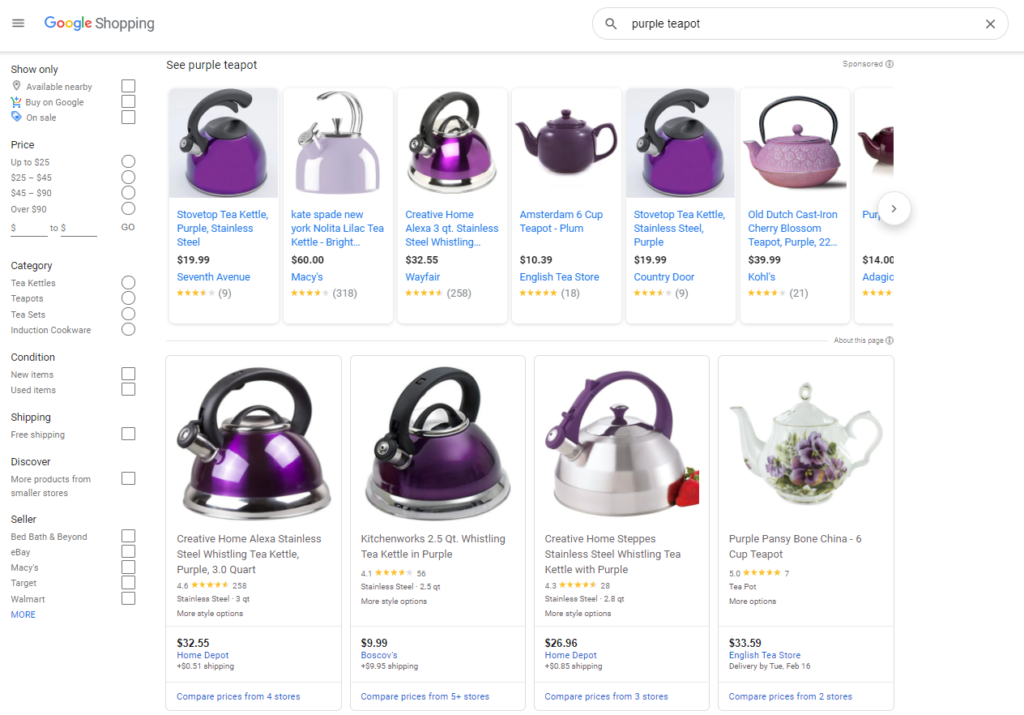
Here, shoppers can search, browse, and even buy products without ever leaving Google.
Want to know more details on how Google Shopping works? Check out our nifty guide.
Listing your products on Google’s comparison shopping engine is completely free. The search engine can find your product details via your website, but you’ll see better results by adding your products to Google Shopping and using Google Shopping Actions (also known as Buy on Google) to let shoppers make their purchases on Google.
Why sell on Google Shopping: Google is one of the highest-traffic channels for shoppers—51% of shoppers research online purchases on Google. Google Shopping helps you get in front of those shoppers and then streamlines the path to purchase with a fast checkout experience. These organic listings have no commission fees—it doesn’t cost you anything when someone purchases your product on Google.
Biggest challenge of Google Shopping: Organic listings on Google Shopping take time to rank on the front page, just like organic listings on Google search results. Realistically, you’ll need to invest some time and budget into running Shopping ads (which are paid) if you want to turn this into a sales engine.
Should you sell on this channel? If you’re already selling on another channel—such as Amazon or your own ecommerce site—you don’t have anything to lose by listing your products on Google Shopping. Google makes it fairly simple to upload your existing product feed on its platform. However, you will need to meet Google Shopping Action’s criteria for shipping, payment processing, and customer service expectations.
Learn more about selling on Google Shopping:
- How to Get Products on Google Shopping: A Step-By-Step Guide
- Google Shopping Actions: The Tool for SMB Growth in 2020
- A Guide to Using Google Ads for Ecommerce
- How to Sell on Google Shopping: 6 Best Practices
eBay: The flexible marketplace for multichannel sellers
With 183 million active buyers worldwide, eBay is a more flexible marketplace than Amazon or Walmart when it comes to establishing a brand. Unlike every other major ecommerce marketplace, eBay gives sellers extended creative control over branding and design for their listings via customizable HTML templates.
While eBay still carries some of its “online flea market” reputation from its early days, it supports sellers of all kinds—not just auctions for used or collectible items. eBay offers a flexible marketplace to anyone, from yard sale resellers to big-name brands.
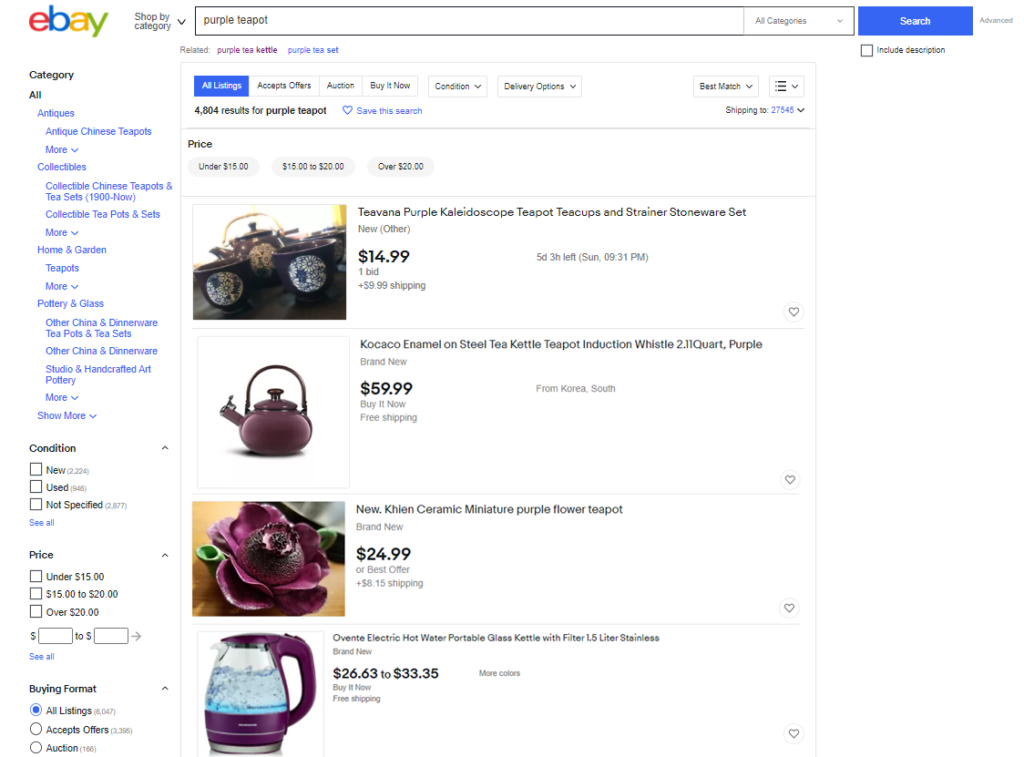
eBay’s fee structure is a little more complicated than other marketplaces, however. You’ll pay two different fees with each eBay sale: your insertion (listing) fee and your final value (selling) fee, both of which depend on your product category.
You get 200 free listings on eBay, and after that, you pay roughly $0.35 per listing, which is charged every time you create a listing in a category (note that you don’t have to create a listing for every single unit). Selling fees usually run you 10% or less of the product’s final selling price. There are additional fees for upgraded listings, but these are optional.
eBay also offers tiered subscription plans that give you additional upgrades and tools, as well as discounts on its standard seller fees.
Why sell on eBay: There’s far less direct competition on eBay than on Amazon, and eBay is not nearly as restrictive with categories and branding. eBay was also voted the number one marketplace for sellers based on the criteria of profitability, customer service (for sellers), communication, and ease of use.
Biggest challenge of selling on eBay: eBay doesn’t have the reputation and traffic as other marketplaces, so it doesn’t carry the same innate trust. You don’t benefit from Amazon’s brand, for example, or Google’s user experience. You have to work harder to establish trust on the marketplace through factors like your seller feedback score and your shipping and return policies.
Should you sell on this channel? eBay’s fees are lower than Amazon’s, which makes it an ideal starting place if you’re looking to just stick your toe in the water of marketplace selling. It’s also great if you sell less conventional items. Just about any kind of product, from handmade to wholesale, can sell well on eBay.
Learn more about selling on eBay:
- Selling on eBay: A Beginner’s Guide for Online Retailers
- Selling on Amazon vs. eBay: Which Is Better For You?
- 10 eBay Selling Tips from Crazily Successful Sellers
- How We Grew our eBay Business from $0 to $100k+ a Month
Walmart: Multichannel selling and Amazon’s biggest competitor
Walmart has the best brand recognition after Amazon for an online marketplace and provides many of the benefits of Amazon—with lower competition and more flexibility.
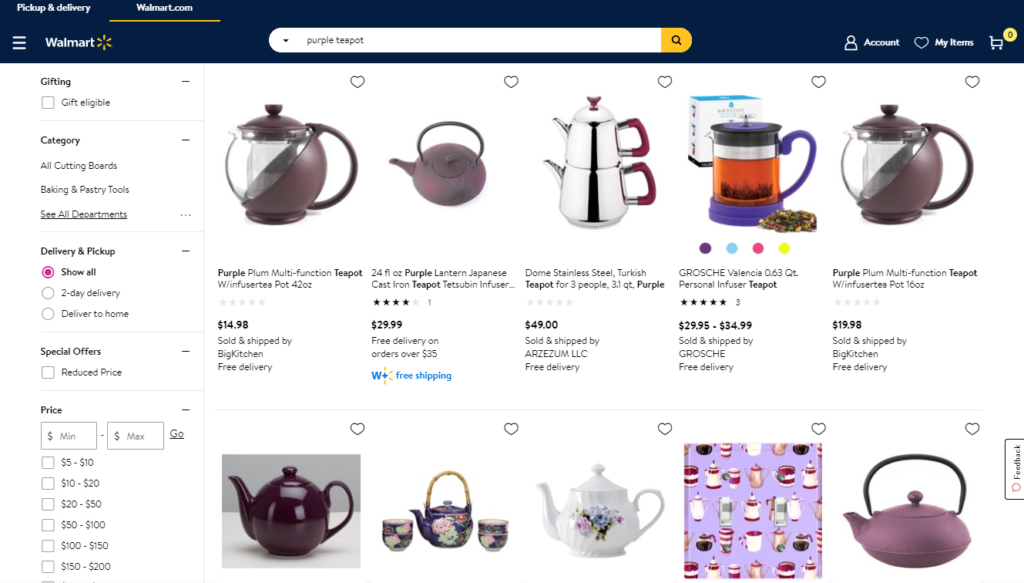
Walmart’s marketplace is much like Amazon—third-party sellers compete with each other and Walmart itself. And as on Amazon, any duplicate products on the marketplace will share a detail page and must compete for Walmart’s Buy Box.
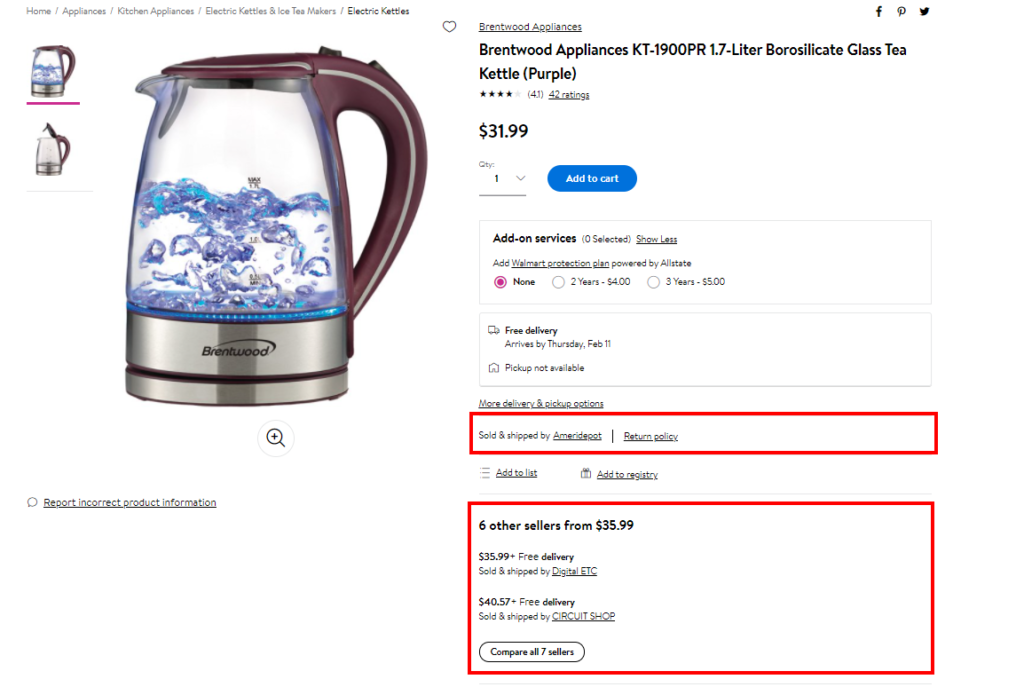
However, Walmart does have one very distinct advantage for sellers: no seller fees. You only pay a referral fee on each sale. (Compare this to Amazon, which has both referral fees and seller fees.) These referral fees range from 8%-20% of the sale price, depending on the category.
Unlike the other marketplaces mentioned, you’ll have to apply and get approval to sell on Walmart. Your eligibility is based in part on a good ecommerce track record.
Why sell on Walmart: Walmart carries the credibility and name recognition of Amazon without the same costs or competition. Walmart is competing with Amazon for customers through programs like Walmart+. It’s also competing with Amazon for sellers by offering programs like Walmart Fulfillment Services (WFS)—which offers the same benefits as FBA but with lower costs.
Biggest challenge of selling on Walmart: You have to be somewhat established on other channels before selling on Walmart, unlike other marketplaces. Walmart wants to see that you can meet its high shipping and service expectations before allowing you onto the marketplace. It also doesn’t give you any branding opportunities (not even a store page, like on Amazon).
Should you sell on this channel? If you’re already selling successfully on one or more channels, Walmart offers a lot of great opportunities to expand your business to an established customer base. This channel will be most useful for you if you already have a solid structure for providing customer service and fast, free shipping (or choose to use WFS). For less established sellers, however, the high demands of Walmart might not yet be worth the effort.
Learn more about selling on Walmart:
- 4 Reasons Why You Need to Sell on Walmart Marketplace
- Walmart vs. Amazon: The Seller’s Guide
- How to Sell on Walmart Marketplace: 14 Best Practices
Etsy: The marketplace for handmade goods
Etsy is the marketplace for handmade and vintage products. It boasts around 45.7 million active buyers and more than 2.5 million active sellers who sell thousands of different kinds of products—from craft supplies and handmade gifts to antiques.
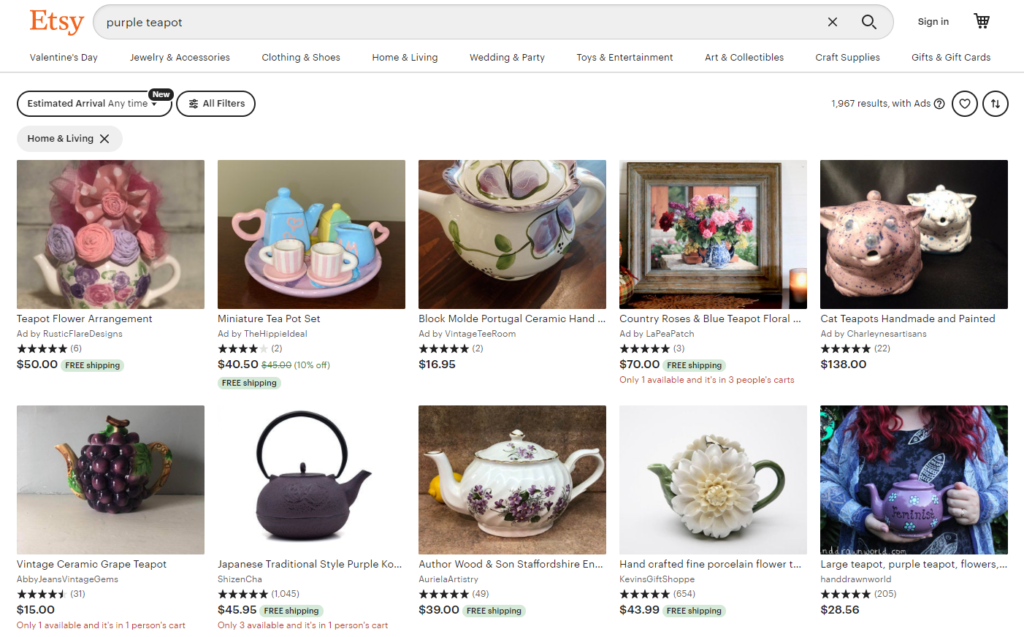
Etsy sellers design shops that feature all of their products, a customized banner, and details about their business. Listings in your shop will appear in Etsy search, but the nature of these shops also makes them easy to promote externally, as well. Many Etsy sellers see a lot of success marketing on social media, particularly on Instagram.
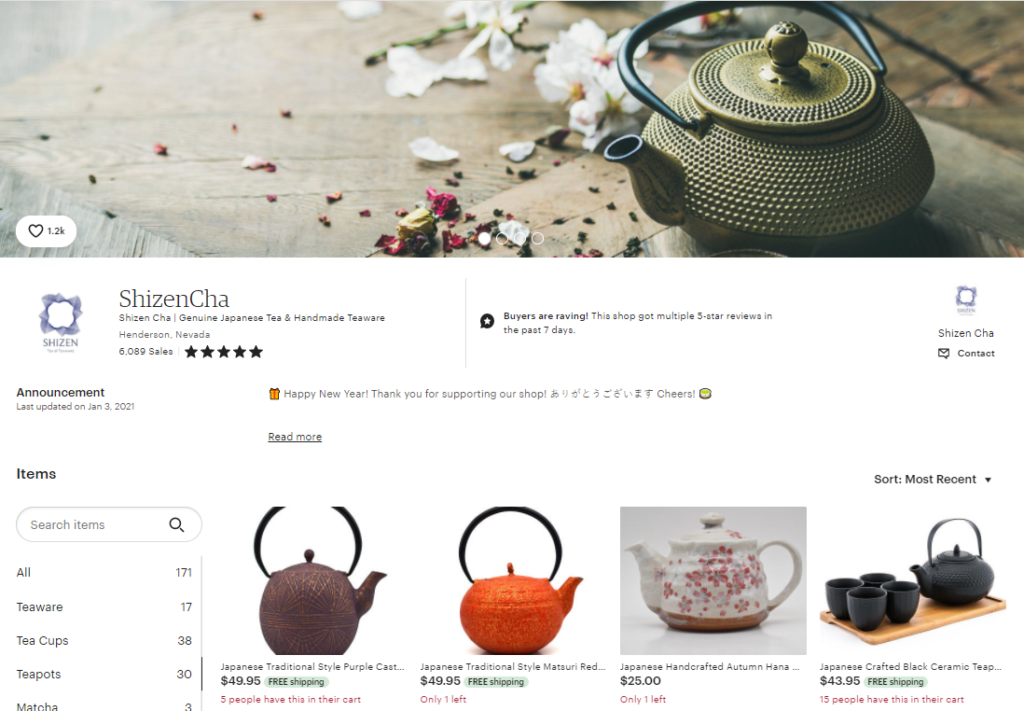
Sellers on Etsy will pay three different kinds of fees: listing, transaction, and payment processing.
- Listing fees. Etsy charges a per-listing fee of $0.20. This fee applies only to the listing itself, regardless of inventory quantity. However, you will need to renew this listing every four months (or when you run out of stock).
- Transaction fees. Etsy charges you a 5% fee on every sale you make. If buyers pay for shipping, Etsy also charges you a 5% shipping transaction fee.
- Payment processing fees. Etsy sellers in eligible countries are required to use Etsy Payments, a payment system that allows shoppers to purchase via popular platforms like PayPal, Amazon Pay, etc. For each sale, you’ll pay a variable processing fee (dependent on your location) for this service.
Want more detail on Etsy’s fee structure? Read our Complete Guide to Etsy Fees.
Why sell on Etsy: Etsy is the place to go to buy unique and handmade items. It makes it very easy for you to set up shop and start selling to a massive audience. The added benefit of Etsy’s audience is that it’s more specialized than the shoppers you’ll find on other sites like Amazon or eBay.
Biggest challenge of selling on Etsy: It’s hard to establish your own brand on the marketplace—people tend to refer to a product as being “from Etsy” versus being from NovelTea Tins, for example. Etsy has also been putting more pressure on sellers to offer free shipping in order to rank in search results. The marketplace also has mandatory offsite advertising for certain sellers, which has led many Etsy businesses to reevaluate the channel’s cost-effectiveness.
Should you sell on this channel? If you want to expand your handmade business, Etsy is still the place to do it. Etsy will work best as a supplementary channel for people who promote and establish their brand off Etsy. The exposure and ease of use make it worthwhile to at least test the channel. Just keep a close eye on your margins to make sure the fees remain manageable.
Learn more about selling on Etsy:
- Selling On Etsy: How to Get Started in Just 10 Days
- How 5 Retailers Turned Their Etsy Shops into Full-Time Jobs
- The 7 Best Things to Sell on Etsy for New Sellers in 2020
- 10 Etsy Tips for Differentiating from Similar Sellers and Products
Don’t fracture your energy—handle multichannel distribution from a single hub
To successfully execute a multichannel distribution system, you have to run your business as a single entity—not offer different customer experiences on different channels.
Inventory management is critical for creating this unified customer experience. You can’t offer excellent service if you find yourself unable to fulfill an Amazon order because a few eBay orders claimed your remaining stock.
Sellbrite offers inventory management software that allows you to monitor and maintain your inventory across all your different sales channels and fulfillment sources. With Sellbrite, you can coordinate your channel listings, inventory levels, fulfillment partners, and shipping details—all from a single hub. No more jumping between marketplace dashboards, fulfillment software, and spreadsheets to manage all your channels.
Sellbrite makes multichannel distribution simple—so you can focus on optimizing your sales channels instead of just keeping up with them.
Learn more about multichannel selling with Sellbrite and start your free trial today.
